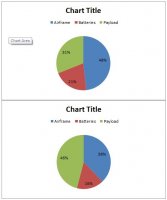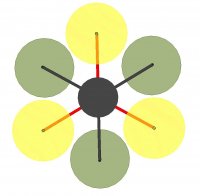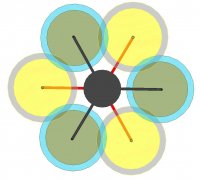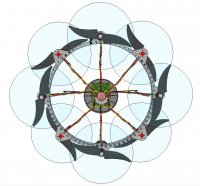You are using an out of date browser. It may not display this or other websites correctly.
You should upgrade or use an alternative browser.
You should upgrade or use an alternative browser.
Payload as a % of AUW
- Thread starter Simspeed
- Start date
R_Lefebvre
Arducopter Developer
A fairly standard rule of thumb is 1/3rd. 1/3 payload, 1/3 battery, 1/3 airframe.
kloner
Aerial DP
i have a few airframes, but to throw out some numbers....
skyjib airframe is 14 lbs, 6 lbs batteries, gimbal weighs from 9 to 17 lbs
another airframe is still in testing stages, but is being tested at 9 lbs airframe, 6 lbs battery, 9 lbs airframe.....
disco.... 3 1/2 lbs airframe, 14 oz battery and a go pro hero....
the later is much more controllable and easier to fly, but it will be carrying the same 17lbs loads soon enough, and it is well in range thrust wise to handle it, none the less, weight is what starts pressing flight envelopes to there limits.
skyjib airframe is 14 lbs, 6 lbs batteries, gimbal weighs from 9 to 17 lbs
another airframe is still in testing stages, but is being tested at 9 lbs airframe, 6 lbs battery, 9 lbs airframe.....
disco.... 3 1/2 lbs airframe, 14 oz battery and a go pro hero....
the later is much more controllable and easier to fly, but it will be carrying the same 17lbs loads soon enough, and it is well in range thrust wise to handle it, none the less, weight is what starts pressing flight envelopes to there limits.
Thanks Kloner....that is interesting and helpful. I assume your airframe weight means ready to fly (includes motors/props/and controls) less batteries. Am I reading it right that you test rig's payload is 9 lbs? Motor weight makes up such a big percentage of frame weight depending on the brand and model used. What motors and props does you skyjib carry? Thanks again for the help. I'm trying to gauge where my X8 design stands in the range of big rigs other people are flying today.
kloner
Aerial DP
my skyjib is 8 times 3520-11 on 15" props and the hexacrafter is 6 times u7 on 16" props.
Yes you read that correctly, they all use retracts and that weight is ready to pack lipos and a gimbal. a big red gimbal is 14-30 lbs depending which one your rolling and whats on it, thats cam, lens, gimbal, filming. Dslr would be up to 10-12 lbs with lens, body, filming, GH3 is 7-9 lbs filming
Yes you read that correctly, they all use retracts and that weight is ready to pack lipos and a gimbal. a big red gimbal is 14-30 lbs depending which one your rolling and whats on it, thats cam, lens, gimbal, filming. Dslr would be up to 10-12 lbs with lens, body, filming, GH3 is 7-9 lbs filming
PeterLester
Member
I quick way to gain perspective visually is via an Excel Pie chart. This image shows Kloners Skyjib with two scenarios.....
minimum payload and maximum payload weights. View attachment 17436
What can be most revealing also is the ratio of the camera versus the Gimbal system weight...... BGC systems tend to be a bit heavy relative to the camera weight.
minimum payload and maximum payload weights. View attachment 17436
What can be most revealing also is the ratio of the camera versus the Gimbal system weight...... BGC systems tend to be a bit heavy relative to the camera weight.
Attachments
R_Lefebvre
Arducopter Developer
Really to have this discussion, you need to define your mission. My 1/3rd rule is for a small hobby type FPV or just-for-fun videography setup with a target flight time of ~20 minutes. Kloners numbers are probably based on the concept of a man-portable airframe capable of lifting a large camera, where flight time isn't a priority. You could build a machine that would fly a Red for 20 minutes, but it wouldn't fit in the back of a truck.  So, if portability is a priority, you sacrifice flight time.
So, if portability is a priority, you sacrifice flight time.
gtranquilla
RadioActive
R_Lefebre,
A very valid point requiring use of eCalc for Multirotors to stay ahead of the game.
A very valid point requiring use of eCalc for Multirotors to stay ahead of the game.
Really to have this discussion, you need to define your mission. My 1/3rd rule is for a small hobby type FPV or just-for-fun videography setup with a target flight time of ~20 minutes. Kloners numbers are probably based on the concept of a man-portable airframe capable of lifting a large camera, where flight time isn't a priority. You could build a machine that would fly a Red for 20 minutes, but it wouldn't fit in the back of a truck.So, if portability is a priority, you sacrifice flight time.
R_Lefebvre
Arducopter Developer
Yes, eCalc is great as long as you understand that it's accuracy breaks down when designing machines that fly for more than 20 minutes. It's pretty hard to get an eCalc past 30 minutes, and I've never been able to surpass 40 minutes, even with T-motors and zero frame weights and NCR18650 batteries. But we know that in reality, people can get these things flying for almost 2 hours.
Really to have this discussion, you need to define your mission. My 1/3rd rule is for a small hobby type FPV or just-for-fun videography setup with a target flight time of ~20 minutes. Kloners numbers are probably based on the concept of a man-portable airframe capable of lifting a large camera, where flight time isn't a priority. You could build a machine that would fly a Red for 20 minutes, but it wouldn't fit in the back of a truck.So, if portability is a priority, you sacrifice flight time.
Hi R_Lefebvre....thanks for your comments. The design I'm working on is posted here http://www.multirotorforums.com/showthread.php?18278-X8-Design-Study. It is a large X8 folding frame and fitted case design for portability and heavy weight capability. I'm designing the frame in 3D cad to optimize functionality, weight, and compactness to fit inside a 10" interior dia. folding tripod case. The majority of parts will be 3D printed nylon with CF tubes to support the arm loads. I want the frame to be able to handle up to 28" props and corresponding motors and control hardware.
Having no first hand knowledge of payload weights, other that what I've learned about here, I'm asking for help to determine where my design weight compares in relation to commercial frames of this capability in balance of airframe/battery/payload weight ratios. It's very interesting to read how heavy some of the camera payloads are of professional videographers, and the types of flight equipment they are using in their businesses.
I am not a videographer, and I will only be flying a gimbal mounted GoPro, but I will be carrying relatively heavy weight during my commercial flights. That business is new venture which I an not yet prepared to announce....but I am hopeful to build quite a number of rigs for the business based on my final design. Proprietary chassis components to mount and manage my payloads are designed and configured to the frame I'm showing but I'll keep those private. I hope this help to address your suggestions. Thanks again....I very much appreciate the information and recommendations of experienced pilots and operators.
TP
Interesting thread here and relevant to my topic...
My AUW currently with the gimbal and camera that I'm running is roughly 6200g.
2168g for frame and elec
2219 payload
1784 Batteries
I'm on a 6S hex w T-motor 3515-400KV running 14x4.8 CF props generating 780g each @ 50% thrust.
My flight times are sadly in the 6-7 min. range w 10800mah. I really want to improve that, so....
My plan was to switch to 16x5 Wooden props (or CF, haven't decided yet) and bump it up to 15000 or 20,000mah even. My issue is, I'm looking at an AUW of 7050g w 15000mah of battery or 7900g w 20,000mah of battery.
With those props, I'm looking at 1180g thrust per motor at 50% throttle. With 15000mah I'm at 1175 per motor. With 20,000mah I'm at 1316g per motor (only needing about 54% throttle to hit my 1316g per motor). Does anyone have any experience with a setup like this? I don't really see the downside to going with bigger props and a bit more weight, but I'd love to hear input. Also, input on CF vs. wooden props would be helpful. Has anyone tried Himodel wooden props? They're the right price for experimenting. Sorry if this is hijacking, but similar topic.
My AUW currently with the gimbal and camera that I'm running is roughly 6200g.
2168g for frame and elec
2219 payload
1784 Batteries
I'm on a 6S hex w T-motor 3515-400KV running 14x4.8 CF props generating 780g each @ 50% thrust.
My flight times are sadly in the 6-7 min. range w 10800mah. I really want to improve that, so....
My plan was to switch to 16x5 Wooden props (or CF, haven't decided yet) and bump it up to 15000 or 20,000mah even. My issue is, I'm looking at an AUW of 7050g w 15000mah of battery or 7900g w 20,000mah of battery.
With those props, I'm looking at 1180g thrust per motor at 50% throttle. With 15000mah I'm at 1175 per motor. With 20,000mah I'm at 1316g per motor (only needing about 54% throttle to hit my 1316g per motor). Does anyone have any experience with a setup like this? I don't really see the downside to going with bigger props and a bit more weight, but I'd love to hear input. Also, input on CF vs. wooden props would be helpful. Has anyone tried Himodel wooden props? They're the right price for experimenting. Sorry if this is hijacking, but similar topic.
NP atpfilms...much of what I'm looking for too. Thanks for your comment and info.
I take it you are calculating needed thrust with the weight of the 20,000 batteries at 1316g (AUW/6)? Do you know your motors with 16x5 props will put out that much thrust ea. at 54% throttle? I'd think you'd want the largest prop the KV rating of your motors can handle to try to get your efficiency rating at the lowest throttle setting possible given that you have prop spacing on your chassis to clear them. That's a pretty light weight flight ready frame...what's your diagonal motor centers dimension? Thanks...TP
I take it you are calculating needed thrust with the weight of the 20,000 batteries at 1316g (AUW/6)? Do you know your motors with 16x5 props will put out that much thrust ea. at 54% throttle? I'd think you'd want the largest prop the KV rating of your motors can handle to try to get your efficiency rating at the lowest throttle setting possible given that you have prop spacing on your chassis to clear them. That's a pretty light weight flight ready frame...what's your diagonal motor centers dimension? Thanks...TP
Last edited by a moderator:
Yes, exactly. with the weight of the 20,000mah batteries, I'm at 1316g per motor (AUW/6). I don't KNOW that my motors with 16x5 props will put out that much thrust at 54%, but that's what the benchmark tests indicate on the motor's website. Could be false. My frame is a 950mm. Don't think I can go any bigger than 16x5's with this frame.
Hmm....has anyone run an offset coaxial X6 with three up at 0-120-240...and three down at 60-180-300? That way you could run bigger prop circles on each side. I saw a link yesterday http://www.multirotorforums.com/showthread.php?18276-Rimcopters where someone had flown this arrangement and said it worked fine. I'll find the link and post it. Here's the link with pictures... http://diydrones.com/forum/topics/octo-x-bicycle-wheel-design-2?commentId=705844:Comment:1453789
View attachment 17470View attachment 17471View attachment 17472View attachment 17473 View attachment 17476
In the first drawing the yellow prop circles are on top and the green circles are on bottom. The first three drawings show 18" prop circles. The last drawing shows 22" prop circles in the blue and gray outside rings. depending on you center section and landing gear layout this might clear or not. Depends on the rest of the chassis. The last drawing is a design I did a few years ago with an offset coaxial X8 layout. The frame dimension here is 692 mm with 15" prop circles.
View attachment 17470View attachment 17471View attachment 17472View attachment 17473 View attachment 17476
In the first drawing the yellow prop circles are on top and the green circles are on bottom. The first three drawings show 18" prop circles. The last drawing shows 22" prop circles in the blue and gray outside rings. depending on you center section and landing gear layout this might clear or not. Depends on the rest of the chassis. The last drawing is a design I did a few years ago with an offset coaxial X8 layout. The frame dimension here is 692 mm with 15" prop circles.
Attachments
Last edited by a moderator:
PeterLester
Member
If you look carefully at eCalc you will see a prop parameter setting at the lower right. If you lower this value in accordance with some of the newer super thin carbon fiber paddle props that are compatible with the newer pancake style motors you will obtain higher flight times in accordance with your actual test flights. Thicker props may be aerodynamically correct but produce more drag relative to lifting capability. And more drag requires more motor torque which in turn reduces total flight time. If not for the Clark airfoil concept that is more common to the wooden prop designs I would also prefer wooden props.....
Interesting thread here and relevant to my topic...
My AUW currently with the gimbal and camera that I'm running is roughly 6200g.
2168g for frame and elec
2219 payload
1784 Batteries
I'm on a 6S hex w T-motor 3515-400KV running 14x4.8 CF props generating 780g each @ 50% thrust.
My flight times are sadly in the 6-7 min. range w 10800mah. I really want to improve that, so....
My plan was to switch to 16x5 Wooden props (or CF, haven't decided yet) and bump it up to 15000 or 20,000mah even. My issue is, I'm looking at an AUW of 7050g w 15000mah of battery or 7900g w 20,000mah of battery.
With those props, I'm looking at 1180g thrust per motor at 50% throttle. With 15000mah I'm at 1175 per motor. With 20,000mah I'm at 1316g per motor (only needing about 54% throttle to hit my 1316g per motor). Does anyone have any experience with a setup like this? I don't really see the downside to going with bigger props and a bit more weight, but I'd love to hear input. Also, input on CF vs. wooden props would be helpful. Has anyone tried Himodel wooden props? They're the right price for experimenting. Sorry if this is hijacking, but similar topic.





